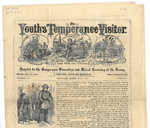Keywords: Small family
- Historical Items (143)
- Tax Records (36)
- Architecture & Landscape (1)
- Online Exhibits (115)
- Site Pages (162)
- My Maine Stories (41)
- Lesson Plans (1)
Online Exhibits
Your results include these online exhibits. You also can view all of the site's exhibits, view a timeline of selected events in Maine History, and learn how to create your own exhibit. See featured exhibits or create your own exhibit
Exhibit
George W. Hinckley and Needy Boys and Girls
George W. Hinckley wanted to help needy boys. The farm, school and home he ran for nearly sixty nears near Fairfield stressed home, religion, education, discipline, industry, and recreation.
Exhibit
2009 marked the bicentennials of the births of Abraham Lincoln and his first vice president, Hannibal Hamlin of Maine. To observe the anniversary, Paris Hill, where Hamlin was born and raised, honored the native statesman and recalled both his early life in the community and the mark he made on Maine and the nation.
Exhibit
This collection of images portrays many buildings in Sanford and Springvale. The images were taken around the turn of the twentieth century.
Exhibit
Presque Isle and the Civil War
Presque Isle had fewer than 1,000 residents in 1860, but it still felt the impact of the Civil War. About half of the town's men went off to war. Of those, a third died. The effects of the war were widespread in the small community.
Exhibit
Northern Threads: Outerwear, Militia & Cadet uniforms
A themed vignette within "Northern Threads Part I," featuring 19th century outerwear, bonnets, militia and cadet uniforms.
Exhibit
Longfellow: The Man Who Invented America
Henry Wadsworth Longfellow was a man and a poet of New England conscience. He was influenced by his ancestry and his Portland boyhood home and experience.
Exhibit
Home Ties: Sebago During the Civil War
Letters to and from Sebago soldiers who served in the Civil War show concern on both sides about farms and other issues at home as well as concern from the home front about soldiers' well-being.
Exhibit
Immigration is one of the most debated topics in Maine. Controversy aside, immigration is also America's oldest tradition, and along with religious tolerance, what our nation was built upon. Since the first people--the Wabanaki--permitted Europeans to settle in the land now known as Maine, we have been a state of immigrants.
Exhibit
From French Canadians to Franco-Americans
French Canadians who emigrated to the Lewiston-Auburn area faced discrimination as children and adults -- such as living in "Little Canada" tenements and being ridiculed for speaking French -- but also adapted to their new lives and sustained many cultural traditions.
Exhibit
Fallen Heroes: Last of the Jewish WWII Veterans
Listen to recordings from the last of the World War II Jewish veterans.
Exhibit
Rum, Riot, and Reform - Why Study the History of Drinking?
"… as much as churches, became the centers of small town activity in the early republic. Generations of later immigrants brought new brewing and…"
Exhibit
Settlers' clothing had to be durable and practical to hold up against hard work and winters. From the 1700s to the mid 1800s, the women of Maine learned to sew by making samplers.
Exhibit
Desserts have always been a special treat. For centuries, Mainers have enjoyed something sweet as a nice conclusion to a meal or celebrate a special occasion. But many things have changed over the years: how cooks learn to make desserts, what foods and tools were available, what was important to people.
Exhibit
"The family, including five sons, moved to Maine in 1946 where Zimelman worked as a cantor at Shaarey Tphiloh in Portland."
Exhibit
Monuments to Civil War Soldiers
Maine supplied a huge number of soldiers to the Union Army during the Civil War -- some 70,000 -- and responded after the war by building monuments to soldiers who had served and soldiers who had died in the epic American struggle.
Exhibit
Like other immigrant groups, Jews came to Maine to make a living and enjoy the natural and cultural environment. Their experiences have been shaped by their occupational choices, Jewish values and, until recently, experiences of anti-Semitism.
Exhibit
Rum, Riot, and Reform - Quenching the Thirst
"… Deviltry, With Jack-Knife Illustrations: Maine's Small-Bore Politicians and Facts About Temperance Hypocrites Benjamin F."
Exhibit
Otisfield's One-Room Schoolhouses
Many of the one-room schoolhouses in Otisfield, constructed from 1839 through the early twentieth century, are featured here. The photos, most of which also show teachers and children, were taken between 1898 and 1998.
Exhibit
Rum, Riot, and Reform - Temperance Membership
"Craftsmen and small manufacturers were increasingly opposed to regular allowances of grog at 11am and 4 pm. Temperance Watchman Club No."
Exhibit
Music in Maine - Country Music
"There was a small family band called Stanhope’s Orchestra that played a few times a year at our local grange hall."
Exhibit
Cultures from the ancient Greeks and Chinese to contemporary societies have set aside time to give thanks, especially for the harvest. In 1941, the United States set a permanent date for the observance.
Exhibit
From the last decades of the nineteenth century through about the 1920s, vacationers were attracted to large resort hotels that promised a break from the noise, crowds, and pressures of an ever-urbanizing country.
Exhibit
Music in Maine - Community Music
"Kemp Family Singers Kemp Family Singers broadside, Leeds, ca. 1895Maine Historical Society George Washington Kemp, Leeds, ca."
Exhibit
Fashionable Maine: early twentieth century clothing
Maine residents kept pace with the dramatic shift in women’s dress that occurred during the short number of years preceding and immediately following World War I. The long restrictive skirts, stiff collars, body molding corsets and formal behavior of earlier decades quickly faded away and the new straight, dropped waist easy-to-wear clothing gave mobility and freedom of movement in tune with the young independent women of the casual, post-war jazz age generation.
























